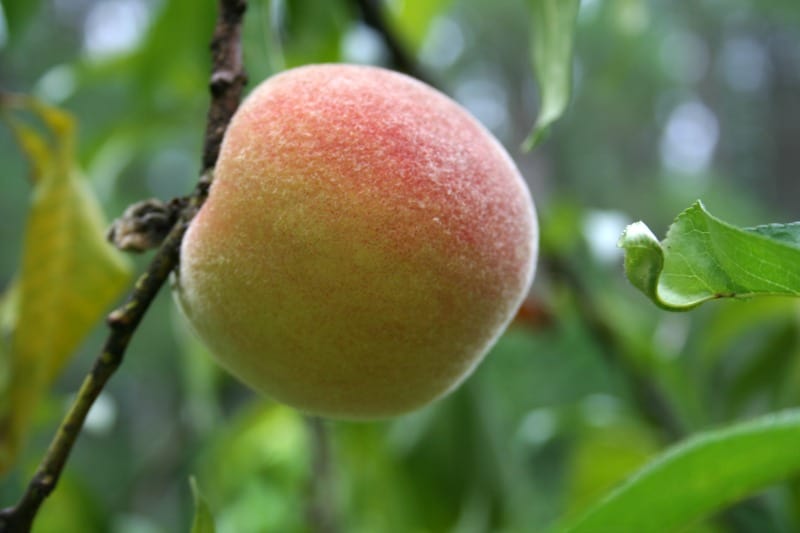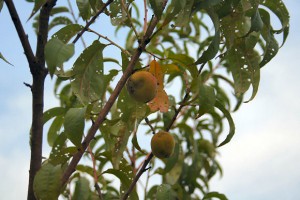The experience of fresh peaches is one you will never forget if you grow your own fruit.

Moths or not, they didn’t get them all. Some peaches were perfect.
The Experience of Fresh Peaches
Last night, my husband came into the living room with a small plate. On the plate was a peach sliced into quarters.
“Here,” he said. “From the garden.”
Gingerly, I picked up a slice. It dripped with juice. I bit into it. The initial flavor burst was a fresh, light peach taste, followed by an aftertaste of vanilla.
It was heavenly. The experience of fresh peaches is one I won’t soon forget.
“This one was pretty good!” he said, happily munching on the rest of the slices.
We have four ripe peaches from the trees this year, a minor miracle considering:
- We were told that the young trees would take several years to establish before bearing fruit.
- The wet spring, followed by a hot and dry summer, seemed less than ideal for peaches.
- We remembered to use the organic spray only twice – once in February, once after blossoms formed. I think the ideal is every two weeks. (But only one insect found in four peaches. Pretty good!)
- Most of the peaches on the tree became moldy before ripening and fell off.
- Some critter got hold of most of what was left and disappeared with them overnight.
- Japanese beetles feast on the tree leaves every year.
But if this is a hint of things to come, I am glad we planted the fruit orchard. We have 27 trees total right now – apples including Golden Delicious, Stayman Winesap, Lodi and Jonathan; four Elberta peach trees; Methly and Burbank plum trees, Bing and Black Tartanian cherry trees, Moorpark and Early Golden apricot trees.
 When we see fresh fruit now, we rejoice. We sample it and marvel that we can actually pick fruit right from a tree in our yard. I’m a city kid at heart, and nobody I knew in Floral Park had fruit trees. My grandma’s Bellerose Long Island garden, with its apple and pear trees and European kitchen garden, was considered an oddity in our suburban area. If people grew food at all, they grew a few tomatoes, since everybody knows that fresh tomatoes always trump store bought ones!
When we see fresh fruit now, we rejoice. We sample it and marvel that we can actually pick fruit right from a tree in our yard. I’m a city kid at heart, and nobody I knew in Floral Park had fruit trees. My grandma’s Bellerose Long Island garden, with its apple and pear trees and European kitchen garden, was considered an oddity in our suburban area. If people grew food at all, they grew a few tomatoes, since everybody knows that fresh tomatoes always trump store bought ones!
Once the trees produce fully, I’ll can the fruit, and we have plans to purchase a dehydrator so that I can dehydrate as much fresh fruit and fruit leathers as possible. But that taste of amazing peach flavor was a taste of achieving a dream, one step closer to producing even more food right here on our own land.




